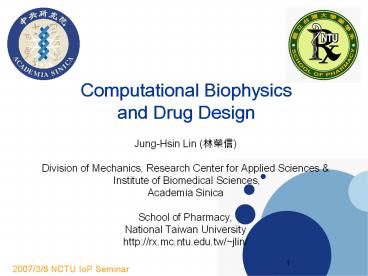Computational Biophysics and Drug Design - PowerPoint PPT Presentation
1 / 37
Title:
Computational Biophysics and Drug Design
Description:
... better bioavailability better metabolites no conflict of interests Integrated Ligand-Based & Structure-Based Virtual Screening of ... The Flexible Docking ... – PowerPoint PPT presentation
Number of Views:161
Avg rating:3.0/5.0
Title: Computational Biophysics and Drug Design
1
Computational Biophysics and Drug Design
- Jung-Hsin Lin (???)
- Division of Mechanics, Research Center for
Applied Sciences - Institute of Biomedical Sciences,
- Academia Sinica
- School of Pharmacy,
- National Taiwan University
- http//rx.mc.ntu.edu.tw/jlin/
2007/3/8 NCTU IoP Seminar
2
Many roles of computation in drug discovery
Computation can be helpful for discovering new
drugs with
- better efficiency
- lower cost
- better affinity to the target
- better selectivity
- better solubility
- better oral availability
- better permeability
- better bioavailability
- better metabolites
- no conflict of interests
3
Integrated Ligand-Based Structure-Based Virtual
Screening of Therapeutic Agents for Huntington
Disease
- Min-Wei Liu (???)
- An-Liang Cheng (???)
4
Attenuation of GPCR Signaling
5
Signaling Pathways from GPCR Families
6
Sequence Alignment for A2A Adenosine Receptors
CLUSTALW score AA2AR_MOUSE 410 , AA2AR_RAT 410
95
CLUSTALW score AA2AR_HUMAN 412 2 AA2AR_MOUSE 410
81
CLUSTALW score AA2AR_HUMAN 412 2 AA2AR_RAT 410
81
7
Training compounds
3
2
4
1
7
8
5
6
11
10
12
9
8
Training compounds
14
15
16
13
17
18
19
20
22
21
23
24
9
Structural Alignment of General Molecules
Carvedilol
Verapamil
10
Verapamil
11
Carvedilol
12
Pharmacophore model for A2A antagonists
- Best HypoGen pharmacophore model Hypo1 aligned to
compound 1
13
Correlation Plot
14
Pharmacophore model for A2A agonists
- Best HypoGen pharmacophore model Hypo2 aligned to
compound 33
15
Correlation Table
16
Correlation Plot
17
Model from GPCR DB
18
Model from ModBase
19
A Novel Global Optimization Algorithm for
Protein-Ligand Interactions
- Jung-Hsin Lin (???)
- Tien-Hao Chang (???)
- Yen-Jen Oyang (????)
20
Characteristics of Biological Complex Problems
- The potential energy function is extremely
rugged. - The potential energy surface is usually highly
asymmetric. - The true global minimum is often surrounded by
many deceptive local minima. - The biological complex problems are mostly in the
space of high dimensionality.
21
The Flexible Docking Problem
22
Thermodynamic Process of Docking
23
AutoDock Scoring Function
J. Comput. Chem. 19 1639-1662 (1998)
- A free energy-based empirical approach.
24
Searching is Generally a Global Optimization
Problem
- Usually there is no general solution.
- Most heuristics cannot guarantee the optimal
solution. - Some of them have been classified as NP-complete
or NP-hard problem.
25
How to explore the phase space?(Or, how to find
a needle in a haystack?)---Importance sampling
- We should only explore the important region of
the phase space, not the entire phase space. - Stochastic methods usually outperform
deterministic approaches in higher dimensional
space.
26
Genetic Algorithm
- Start Generate random population of n
chromosomes (suitable solutions for the problem) - Fitness Evaluate the fitness f(x) of each
chromosome x in the population - New population Create a new population by
repeating following steps until the new
population is complete - Selection Select two parent chromosomes from a
population according to their fitness (the better
fitness, the bigger chance to be selected) - Crossover With a crossover probability cross
over the parents to form new offspring
(children). If no crossover was performed,
offspring is the exact copy of parents. - Mutation With a mutation probability mutate new
offspring at each locus (position in chromosome).
- Accepting Place new offspring in the new
population - Replace Use new generated population for a
further run of the algorithm - Test If the end condition is satisfied, stop,
and return the best solution in current
population - Loop Go to step 2
27
Chromosomes for Flexible Docking
Crossover operation
Leach, 2001.
28
Lamarckian Genetic Algorithm
- LGA is a hybrid of the Genetic Algorithm with
the adaptive local search method. - As in the GA scheme, energy is regarded as the
phenotype, and the compound conformation and
location are regarded as the genotype. - In the LGA scheme, phenotype is modified by the
local searcher, and then the genotype is modified
by the locally optimized phenotype. - In AutoDock, the so-called Solis-Wet algorithm
is used (basically energy-based random move).
29
The Rank-based Adaptive Mutation Evolutionary
Algorithm
Nucleic Acids Research 33 W233-W238 (2005)
- n individuals, denoted by s1, s2, , sn, are
generated. Each si is a vector corresponding to
a point in the domain of the objective function
f . In order to achieve a scale-free
representation, each component of si is linearly
mapped to the numerical range of 0,1. - The individuals in each generation of population
are then sorted in the ascending order based on
the values of the energy function on evaluated on
these individuals. Let t1, t2, tn denote the
ordered individuals and we have
f(t1)ltf(t2)ltf(tn). - n Gaussian distributions, denoted by G1, G2,
Gn, are generated before the new generation of
population is created. The center of each
Gaussian distribution is selected randomly and
independently from t1, t2, tn, where the
probability is not uniform but instead follows a
discrete diminishing distribution, n n-1
1.
30
The RAME Algorithm
31
LGA versus RAME
32
(No Transcript)
33
(No Transcript)
34
http//bioinfo.mc.ntu.edu.tw/medock/, Nucleic
Acids Research 33 W233-W238 (2005)
35
Randomized Benchmark Functions
m dimensionality
36
Performance of LGA vs. ME for a Random Benchmark
Function
Probability of finding the global minima
Number of runs
37
Summary for the RAME Algorithm
- Our new RAME algorithm can find out the global
minima for complex potential functions below
dimensionality of 30 with substantial finite
probability, which is suitable for most docking
applications. - The RAME algorithm avoids the purification
effect inherent in the genetic algorithm and its
derivatives, and therefore reduce the
over-compression of information in the searching
process.































